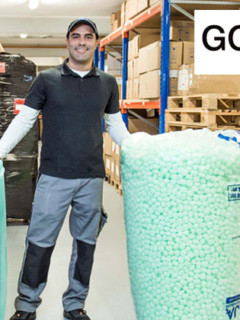In our highly technical world, global trade is constantly increasing. In the course of this, it is also necessary to ship more and more goods from which one or more hazards may emanate, such as explosive substances, toxic substances or radioactive materials. According to the Federal Ministry of Transport, Building and Urban Affairs (BMVI), 400 million tonnes of dangerous goods of various classes are transported in Germany alone every year. If an accident occurs during such a transport or if the goods are handled incorrectly, this can have major consequences for people, nature and animals in the vicinity. Therefore, special regulations and requirements apply to the packaging material and labelling when shipping and packaging dangerous goods. We show you which dangerous goods you have to label and how, and what you have to pay attention to when transporting dangerous goods.
Definition of hazardous substance and dangerous goods
All substances and objects that pose a risk to people and the environment as well as to public safety and order are classified as hazardous substances. Due to the physical, toxicological or chemical properties of hazardous substances, accidents or improper handling may result in explosions, environmental damage or fire. The term dangerous goods, on the other hand, refers to the transport of hazardous substances on public transport routes (road, sea and inland waterway vessels, railways, air transport). Regulations for the transport of dangerous goods have been developed from the recommendations of the United Nations (UN). There are separate sets of regulations for each of the five modes of transport. The aim of these regulations is to ensure the highest possible level of safety for the life and health of humans and animals and to avert dangers to public safety. The BMVI (Federal Ministry of Transport and Infrastructure) has summarised all the essential points in an information brochure on the transport of dangerous goods. Particular attention is paid to the training of personnel in the handling of dangerous goods.
Dangerous goods labelling: UN number, warning plate and danger label
Dangerous goods must be clearly recognised and labelled as such. This is done in the form of danger labels and UN numbers. Each dangerous good is included in a list and assigned its own four-digit number, the so-called UN number, also known as the substance number. This number is used for identification and makes it possible to clearly identify the dangers posed by each dangerous good and thus to quickly take the necessary safety precautions. For road and rail vehicles, the number is deposited on an orange warning plate. The warning plate is particularly important for the fire brigade in the event of accidents and must be clearly visible on every truck transporting dangerous goods. For consignments of goods and packaging, the UN number can be affixed in the form of a label. In this case, specific regulations on the height of the mark in relation to the capacity must be observed. So-called danger labels are required as additional labelling. These are squares on the top which represent the hazard label class and have a hazard symbol depending on the class and are coloured differently. In addition, further special features apply to the repackaging of several hazardous substances and the shipment of limited quantities (LQ).

Read more directly: Limited quantity regulations for secondary packaging
Classify dangerous goods correctly: The nine valid dangerous goods classes
Based on their characteristic properties, hazardous substances are classified into globally standardised dangerous goods classes on the basis of UN recommendations. These are also used by the European Union and other countries for legal regulations. According to the nine classifications for the hazard classes, dangerous goods labels on shipping packages show a number (from 1 to 9). For example, a distinction is made between flammable liquids (Class 3) or flammable solids (Class 4), but also flammable substances (Class 5) or corrosive substances (Class 8). This means that it is immediately apparent from the label on the outer packaging what type of hazardous substance it is. If a substance has several hazardous properties, these are indicated in the form of subsidiary or additional hazards. The order of the ADR class says nothing about how dangerous the classified substances are, but only how they must be packed and shipped due to their properties. The dangerous goods classes of the European Agreement concerning the International Carriage of Dangerous Goods by Road – ADR are as follows:

- Dangerousgoods class 1: Explosive substances and articles with explosive properties that can explode quickly in the event of fire or sparks, e.g. fireworks or ammunition.
- Dangerousgoods class 2: Gases or gas mixtures containing spontaneously combustible substances, some of which are toxic, e.g. hair spray, lighters, gas cylinders, deodorant.
- Dangerousgoods class 3: Liquid substances which are highly flammable e.g. alcohol, pesticides, petrol and varnishes.
- Dangerousgoods class 4: Solid substances which are highly flammable e.g. contaminated cleaning rags, magnesium shavings, sealing compound, matches, sulphur and rubber residues.
- Dangerousgoods class 5: Oxidising substances which may cause other substances to catch fire on contact, e.g. sodium nitrate, potassium nitrate, acetone, oxygen, nitric acid.
- Dangerousgoods class 6: Toxic substances and infectious substances which may cause damage to the health of humans and animals, e.g. hydrocyanic acid, arsenic, pesticides and pathogenic agents such as, in the case of infectious substances, infected samples, etc.
- Dangerous goods class 7: Radioactive substances emitting radioactive radiation, e.g. nuclear waste, uranium, plutonium, medical instruments and hazardous waste.
- Dangerousgoods class 8: Corrosive substances that can harm people, goods and means of transport e.g. sulphuric acid, cement, drain cleaners, caustic soda solution.
- Dangerousgoods class 9: Various dangerous substances and objects that can be dangerous during the transport of dangerous goods and do not fit into any other class, e.g. asbestos, airbags, water-polluting substances, dry ice, lithium batteries.
For the transport of dangerous goods by road, service providers must comply with the ADR regulations, which summarise specific regulations on load securing as well as packaging and labelling of dangerous goods. Based on the danger label classes, the labelling (marking) is regulated so that a clear marking of dangerous goods is made on the dangerous goods boxes and other containers as well as on the truck itself.
Dangerous goods packaging for shipping in accordance with regulations
Example of a link text in the table of contents
Transport begins with the filling, packing and labelling of dangerous goods and does not end until the goods are unpacked and ready for the recipient. Particular importance is therefore attached to the packaging of dangerous goods. The principle applies: the more dangerous a substance is, the safer the packaging must be. For this reason, dangerous goods packaging is tested and approved by the authorities. The United Nations has set test criteria for this, which include drop testing, pressure and stacking testing, as well as chemical resistance testing. Tested dangerous goods packaging is marked with a UN packaging number that shows exactly what can be transported with it and where it was tested.
Shipping different dangerous goods? Mark the outer packaging!
If several dangerous goods and hazardous substances are to be shipped, it is also possible to bundle packages, e.g. on a pallet or in a storage box, in the form of composite packaging. The outer packaging can consist of conventional stretch film or a cardboard box. If the dangerous goods markings of the inner packaging are then no longer visible, it is of course also necessary to specially mark this outer packaging. In addition to all dangerous goods markings on the individual packages (hazard labels and UN numbers), labels with the phrase “outer packaging” must be affixed.
Shipping hazardous liquids
If the packaging contains liquid substances, a label with alignment arrows must be affixed on two opposite sides, irrespective of the dangerous goods class, provided that the closures of the transport containers are not visible from the outside. When transporting environmentally hazardous substances, the dangerous goods label must be affixed with the fish and tree symbol, which is not assigned a specific hazard class. If dangerous goods are to be transported by sea or air, these dangerous goods labels are not yet sufficient. Special labelling and transport obligations apply to these transport routes.
Shipment in limited quantities (LQ)
Strict transport regulations apply to dangerous goods. Partially exempt from these regulations is the transport of limited quantities (LQ). This means that packages consisting of several individual inner packages (such as bottles) and one outer package (for example a cardboard box) are subject to less strict regulations. Limited quantities are marked with an LQ label to indicate that they are being shipped in limited quantities. The background: If, for example, one transports 10 litres of flammable liquid in a canister that leaks, in case of doubt the full 10 litres have leaked. If the same quantity of liquid is filled into 10 bottles of one litre each, one of which may be defective, a much smaller quantity of the hazardous substance will leak. In general, a maximum weight of 30kg per outer packaging applies to limited quantities. The ADR (European Agreement concerning the International Carriage of Dangerous Goods by Road – Table A) and the RID (Regulations concerning the International Carriage of Dangerous Goods by Rail) specify which substances are permitted for transport in limited quantities and in which (individual) quantities. Further information on the ADR and the transport of limited quantities is available from the Federal Ministry of Digital Affairs and Transport.
Transport of dangerous goods in exceptional situations
The Covid-19 pandemic has also pushed some rules to their limits in the area of dangerous goods transport. On the one hand, urgently needed ADR training and other courses could not be carried out or could not be carried out on time, which would theoretically result in the expiry of licences. On the other hand, it is in everyone’s best interest to ensure the transport of certain substances such as disinfectants of medical products and very special medical gases (e.g. oxygen) as simply as possible and without hurdles, even internationally. For this reason, the Federal Ministry of Transport and Digital Infrastructure had adopted several international regulations that simplified the handling of the relevant dangerous goods and allowed the continued use of training certificates for a transitional period.















